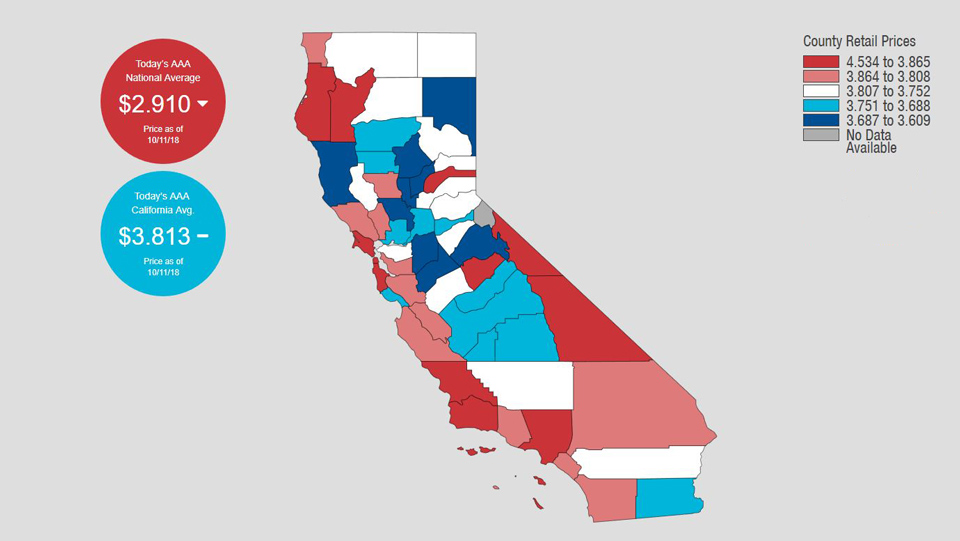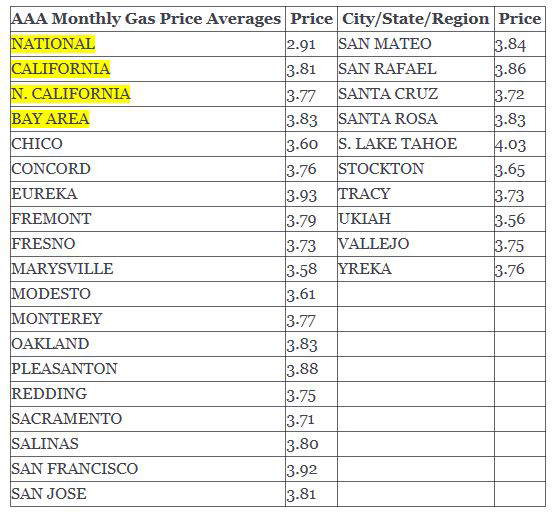
Speculation over Iran sanctions has caused crude oil prices to jump 25 percent in 2018
October 11, 2018 - WALNUT CREEK, Calif. - Californians typically see a big decrease in fuel prices after the summer driving season, but gas prices in the Golden State have jumped almost 20 cents in the last month.
On Sept. 11, Californians paid an average of $3.62 for a gallon of regular unleaded gasoline. Today, the statewide average price is $3.81.
The unusual late-season spike is being driven by Wall Street speculation as the United States prepares to issue additional sanctions against Iran. Analysts say the Iran economic sanctions, set to take effect on Nov. 4, could remove 1.5 million barrels per day from the global oil market, causing supplies to dwindle and worldwide oil prices to soar above $100 per barrel. Currently, oil is trading near $80 a barrel; at the beginning of 2018, crude oil prices were closer to $50 a barrel.
Other analysts have been more cautious, predicting that Iran sanctions would not have a significant effect on worldwide oil supplies.
"Everyone is watching to see how much the Iranian sanctions will actually impact the global market," said Michael Blasky, spokesman for AAA Northern California. "Some speculators are betting on $100 oil prices, and if that occurs, it would likely bring California's gas prices over $4 a gallon yet again."
The last time California had a $4 state average was July 27, 2014. Today's statewide average is the highest price since July, 2015.
Gasoline prices are directly dependent on global oil prices. Californians generally pay higher prices at the pump than other states due to our higher taxes on fuel, and stricter environmental requirements that limit supply options. Because California requires a more-refined gasoline formula than other states, only refineries within California have incentive to produce that gasoline.
"Because of our environmental requirements, California's fuel market is very isolated from the rest of the United States. Almost all of the gasoline in California is produced from California refineries," Blasky said.
California also requires refineries to produce a summer blend that is more environmentally friendly, but more expensive to produce. California is using summer specifications for gasoline until November, but the rest of the country has transitioned to easier-to-make autumn blends.
"Californians should get a price break when the state switches from our summer blend of gasoline, which is more expensive to produce than our winter blend," Blasky said. "But right now, it doesn't appear that we'll see the typical 25 to 60-cent decrease that usually occurs at the end of the year."
AAA October 2018 Gas Price Report

AAA’s Fuel Gauge Report is the most comprehensive retail gasoline survey available, with over 100,000 self-serve stations surveyed every day, nationwide. Data is provided in cooperation with OPIS Energy Group and Wright Express, LLC.
We have a proud, 117 history of serving over 4 million Californians. We are more than our legendary fleet of tow trucks, auto, home, life insurance and travel services. Our mission is to make a positive impact in the communities we serve, offering smarter solutions that improve traffic safety and helping the public adapt to a fast-changing mobility landscape. Learn more at AAA.com.
Source: AAA
